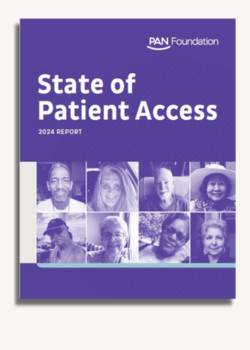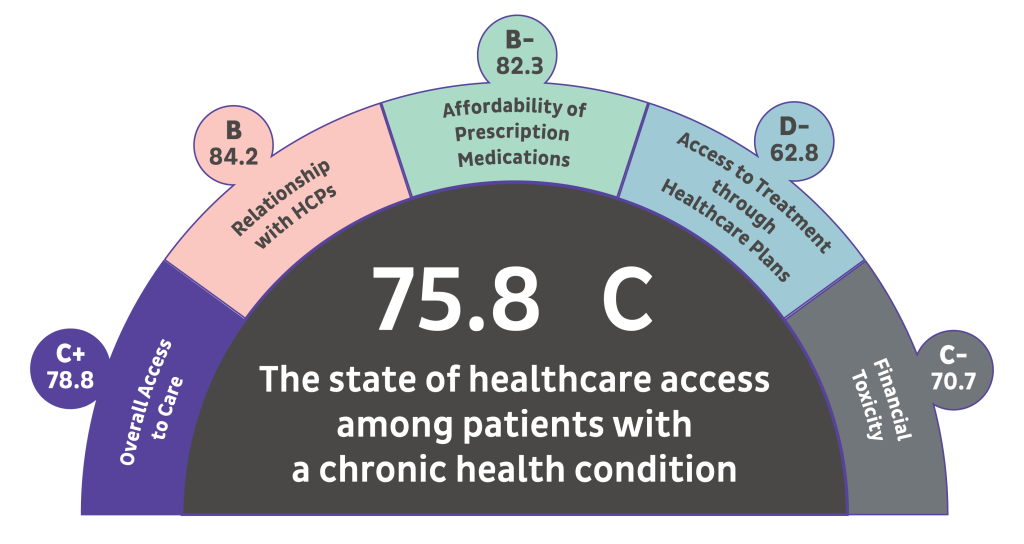The PAN Foundation’s Center for Patient Research issues new healthcare scorecard that reveals access issues for chronically ill patients
Cornerstone research by the Patient Access Network (PAN) Foundation’s Center for Patient Research highlights continued inequities facing patients with chronic illnesses across the U.S.
Today the PAN Foundation’s Center for Patient Research released its inaugural 2024 State of Patient Access Report, which reveals adults with chronic conditions (referred to as ‘patients’ throughout) across demographics face deep challenges accessing and affording needed healthcare and treatment. Based on a new nationwide survey, conducted by The Harris Poll, a scorecard was developed to provide composite ratings for five key categories related to patient access to care:
- Overall Access to Care = C+ (78.8)
- Relationship with Healthcare Professionals = B (84.2)
- Affordability of Prescription Medications = B- (82.3)
- Access to Treatment through Healthcare Plans = D- (62.8)
- Financial Toxicity = C- (70.7)
The ability to access treatment through their healthcare plans earned a “D-” across all patients, the lowest overall grade across the five categories. Nearly half (49 percent) of insured patients with chronic diseases who take prescription medication(s) reported they had faced some form of insurance-related barrier to accessing their prescriptions. In addition, nearly 3 in 5 (58 percent) patients said they worry that over the next five years, their health plan will make it more difficult for them to access their needed prescriptions. Virtually all (96 percent) patients surveyed are insured through public or private health insurance.
Our 2024 State of Patient Access Report spotlights the all-too-common challenges facing patients with chronic disease in accessing needed healthcare—from insurance barriers to medication costs.
Amy Niles, Chief Mission Officer, PAN Foundation
Notably, the score for this category fell to a failing grade of an “F” among Hispanic, Native American or Pacific Islander, and LGBTQIA+ patients, as well as younger patients (Gen Z or Millennials), and those with lower incomes (less than $50K), highlighting the pervasiveness of health disparities and the impact of a patient’s race, identity, age, or income level on their ability to access care through their health plans.
“Our 2024 State of Patient Access Report spotlights the all-too-common challenges facing patients with chronic disease in accessing needed healthcare—from insurance barriers to medication costs,” said Amy Niles, Chief Mission Officer at the PAN Foundation. “We know disparities in healthcare are rooted in racism, bias, structural inequities, social and economic disadvantages, and inefficiencies in the healthcare system. To bring about needed change, key stakeholders need to shape an action-oriented policy agenda that chips away at these deep systemic flaws and expands access to affordable, equitable care. We must also educate policymakers about these issues and encourage them to enact meaningful policies that improve healthcare access.”
Additional findings
Other key findings in the 2024 report underscore inequities inherent in healthcare access, including:
- Patients identifying as LGBTQIA+ (77 percent), Native American or Pacific Islander patients (76 percent), and Hispanic patients (61 percent) were more likely to experience logistical challenges accessing needed healthcare than non-LGBTQIA+ patients (47 percent) or white patients (45 percent).
- More than one-quarter (31 percent) of patients in the LGBTQIA+ community who have received healthcare in the past 12 months rated the quality of the care they received as poor or fair, compared to 17 percent of non-LGBTQIA+ patients.
- Nearly 2 in 5 (38 percent) patients reported feeling that some aspects of their identity—such as their race/ethnicity, age, gender identity, income, etc.—negatively impacted their ability to get the best possible healthcare.
The report also highlights that many patients struggle to afford or obtain prescription medications due to cost. In fact, more than one-third (36 percent) of patients taking prescription medications said they had taken at least one financially related action to afford their needed prescription medication(s). This included reducing their spending in other areas (15 percent), dipping into retirement or other savings (13 percent), exploring discount saving apps (12 percent), taking on credit card debt (11 percent), or delaying payment of other bills (10 percent).
All patients surveyed had been diagnosed by a healthcare professional with at least one chronic health condition. More than half (55 percent) had multiple chronic health conditions.
About the State of Patient Access Report

The State of Patient Access Report is a flagship research initiative of the PAN Foundation’s new Center for Patient Research, dedicated to providing evidence-based insights that convey the diverse needs of patients as they navigate the healthcare system and challenges accessing affordable, equitable care. Through rigorous methodologies, the Center for Patient Research aims to understand the challenges faced by patients, translate these findings into actionable knowledge for healthcare stakeholders and policymakers, and help inform policies that lead to accessible, equitable, and affordable healthcare for all.
Patient survey methodology
The research was conducted online in the United States by The Harris Poll on behalf of the PAN Foundation among 2,502 completes age 18+ who reside in the U.S. and have by diagnosed by a healthcare professional with a chronic health condition (including 2,367 completes from the general population and race/ethnicity oversamples and 135 completes from the LGBTQIA+ oversample). The survey was conducted August 10–September 6, 2023.
Data for the Gen Pop sample and Hispanic, Black/African American, Asian, and Native Hawaiian/Other Pacific Islander/American Indian/Alaskan Native race/ethnicity subgroups are each weighted individually where necessary by: age, gender, race/ethnicity (total Gen Pop data only), Asian subgroup (Asian data only), Native subgroup (Native Hawaiian/Other Pacific Islander/American Indian/Alaskan Native data only), region, education, marital status, household size, employment, household income, aggregated language proficiency (Hispanic only), LGBTQIA+ status (excluding Native Hawaiian/Other Pacific Islander/American Indian/Alaskan Native), and propensity to be online to bring them in line with their actual proportions in the population. A post-weight was then applied to combine all data and weighted where necessary by race/ethnicity. Separately, due to overlap with the other samples, data for the LGBTQIA+ sample are weighted where necessary by age, gender, education, race/ethnicity, sexual orientation, region, household size, marital status, and propensity to be online to bring them in line with their actual proportions in the population.
Respondents for this survey were selected from among those who have agreed to participate in our surveys. The sampling precision of Harris online polls is measured by using a Bayesian credible interval. For this study, the sample data is accurate to within + the below percentage points using a 95 percent confidence level:
- Total: + 2.9 percentage points
- Hispanic: + 7.8 percentage points
- Black/African American: + 6.0 percentage points
- Asian: + 9.6 percentage points
- Native Hawaiian/Other Pacific Islander/American Indian/Alaskan Native: + 13.8 percentage points
- LGBTQIA+: + 7.2 percentage points
This credible interval will be wider among subsets of the surveyed population of interest. All sample surveys and polls, whether or not they use probability sampling, are subject to other multiple sources of error which are most often not possible to quantify or estimate, including, but not limited to coverage error, error associated with nonresponse, error associated with question wording and response options, and post-survey weighting and adjustments.
Scorecard methodology

To assess the state of patient access in the United States, The Harris Poll—on behalf of the PAN Foundation—synthesized the patient survey results into a 2024 State of Patient Access Scorecard, organized across five key categories. To arrive at an aggregate score for each domain, they used composite indices, which incorporate a variety of survey questions and response options, each assigned a weight. The weights assigned to each question or response option total 100 within each index category. Individual respondents were then assigned a score between zero and 100, based on their responses to the survey questions included in the indices. The average of all respondents’ scores resulted in a composite index score, which summarizes a subset of attributes or dimensions into a single metric. Each metric synthesizes patients’ views and experiences in a particular domain. The scores were calculated both at the total patient level, and for a variety of subgroups within the broader patient population to highlight any disparities in access to care.
About the PAN Foundation
The PAN Foundation is an independent, national 501 (c)(3) organization dedicated to helping federally and commercially insured people living with life-threatening, chronic, and rare diseases with the out-of-pocket costs for their prescribed medications.
Since 2004, we have provided more than 1.1 million underinsured patients with $4 billion in financial assistance. Partnering with generous donors, healthcare providers and pharmacies, we provide the underinsured population access to the healthcare treatments they need to best manage their conditions and focus on improving their quality of life. Learn more at panfoundation.org.
